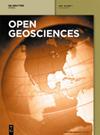On the use of low-frequency passive seismic as a direct hydrocarbon indicator: A case study at Banyubang oil field, Indonesia
IF 1.7
4区 地球科学
Q3 GEOSCIENCES, MULTIDISCIPLINARY
引用次数: 0
Abstract
Low-frequency passive seismic (LFPS), discussed in recent years, has emphasized a strong correlation between the spectral properties and the presence of hydrocarbon reservoirs. While the theoretical background supporting this phenomenon is still debated, its application has been popular in Indonesia and exposes broad possibilities for exploration. In this study, we conducted a survey at an oil field in Central Java, Indonesia, investigating the case of using this technique as a direct hydrocarbon indicator (DHI). In spatial and temporal measurements, we examined the hydrocarbon-related energy above the reservoir boundary based on several attributes of passive seismic recordings: polarization, power spectral density (PSD), and vertical-to-horizontal spectral ratio (VHSR). We address some issues: (1) the anomalies are not always vertically polarized, so the use of VHSR is unlikely to be reliable; and (2) the anomalies are getting amplified during days, so in anomalies mapping, normalizing the amplification requires calibration. Regardless, LFPS is still applicable in quantifying hydrocarbon-related energy. We recommend using PSD as a primary spectral attribute for DHI. In addition, it is also critical to synchronize the measurements at different sites to obtain an unbiased quantification of hydrocarbon-related energy.关于使用低频被动地震作为碳氢化合物直接指示器:印度尼西亚 Banyubang 油田案例研究
近年来讨论的低频被动地震(LFPS)强调了频谱特性与油气藏存在之间的密切联系。虽然支持这一现象的理论背景仍有争议,但其应用已在印尼普及,并为勘探提供了广阔的可能性。在本研究中,我们在印尼中爪哇的一个油田进行了调查,研究将该技术用作直接碳氢化合物指示器(DHI)的情况。在空间和时间测量中,我们根据被动地震记录的几个属性:极化、功率谱密度(PSD)和垂直-水平谱比(VHSR),检查了储层边界上方与油气相关的能量。我们解决了一些问题:(1)异常并不总是垂直极化的,因此使用 VHSR 不太可能可靠;(2)异常在白天会被放大,因此在绘制异常图时,将放大归一化需要校准。无论如何,LFPS 仍然适用于碳氢化合物相关能量的量化。我们建议使用 PSD 作为 DHI 的主要光谱属性。此外,在不同地点同步进行测量对于获得无偏的碳氢化合物相关能量量化也至关重要。
本文章由计算机程序翻译,如有差异,请以英文原文为准。
求助全文
约1分钟内获得全文
求助全文
来源期刊

Open Geosciences
GEOSCIENCES, MULTIDISCIPLINARY-
CiteScore
3.10
自引率
10.00%
发文量
63
审稿时长
15 weeks
期刊介绍:
Open Geosciences (formerly Central European Journal of Geosciences - CEJG) is an open access, peer-reviewed journal publishing original research results from all fields of Earth Sciences such as: Atmospheric Sciences, Geology, Geophysics, Geography, Oceanography and Hydrology, Glaciology, Speleology, Volcanology, Soil Science, Palaeoecology, Geotourism, Geoinformatics, Geostatistics.
 求助内容:
求助内容: 应助结果提醒方式:
应助结果提醒方式:


